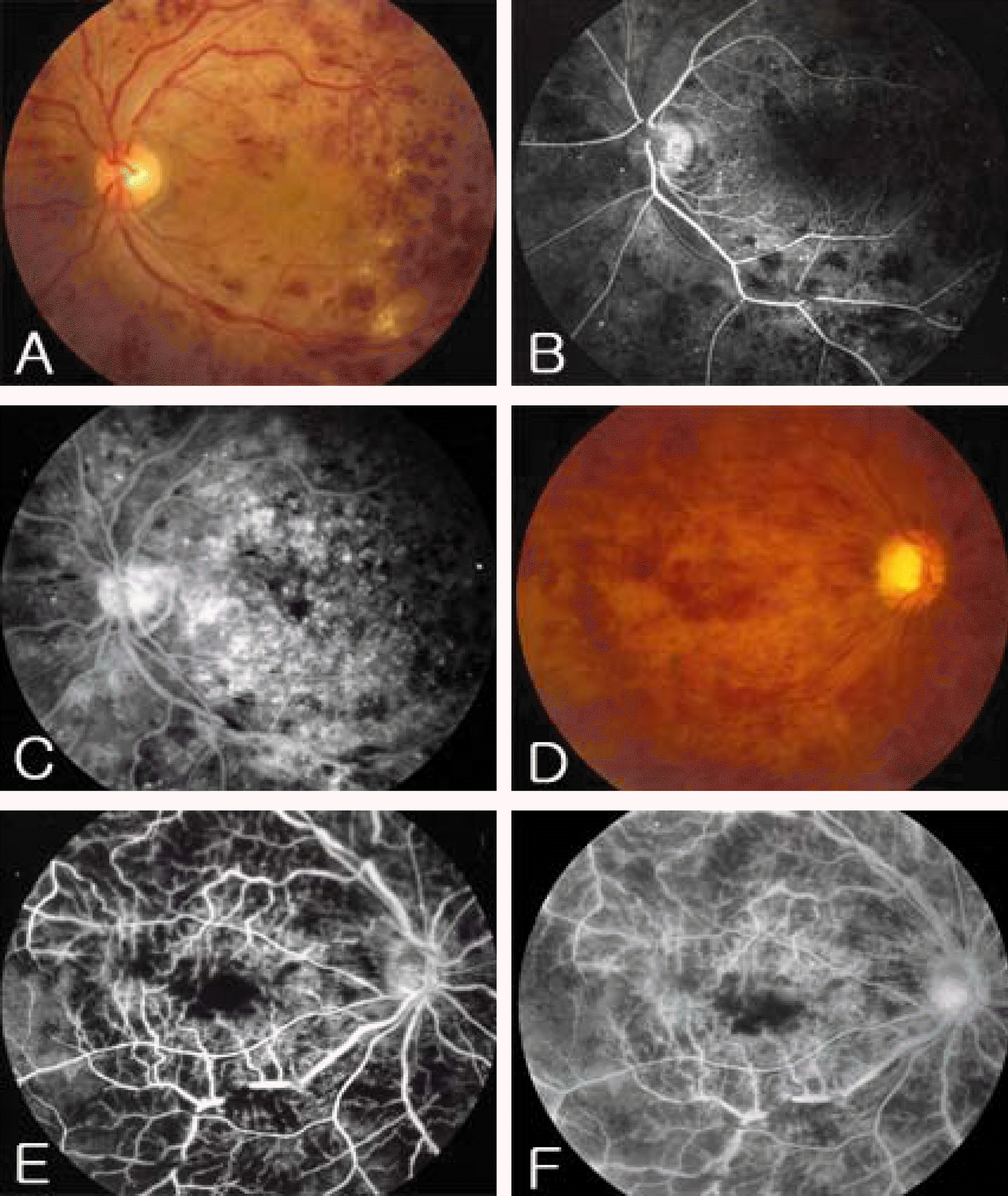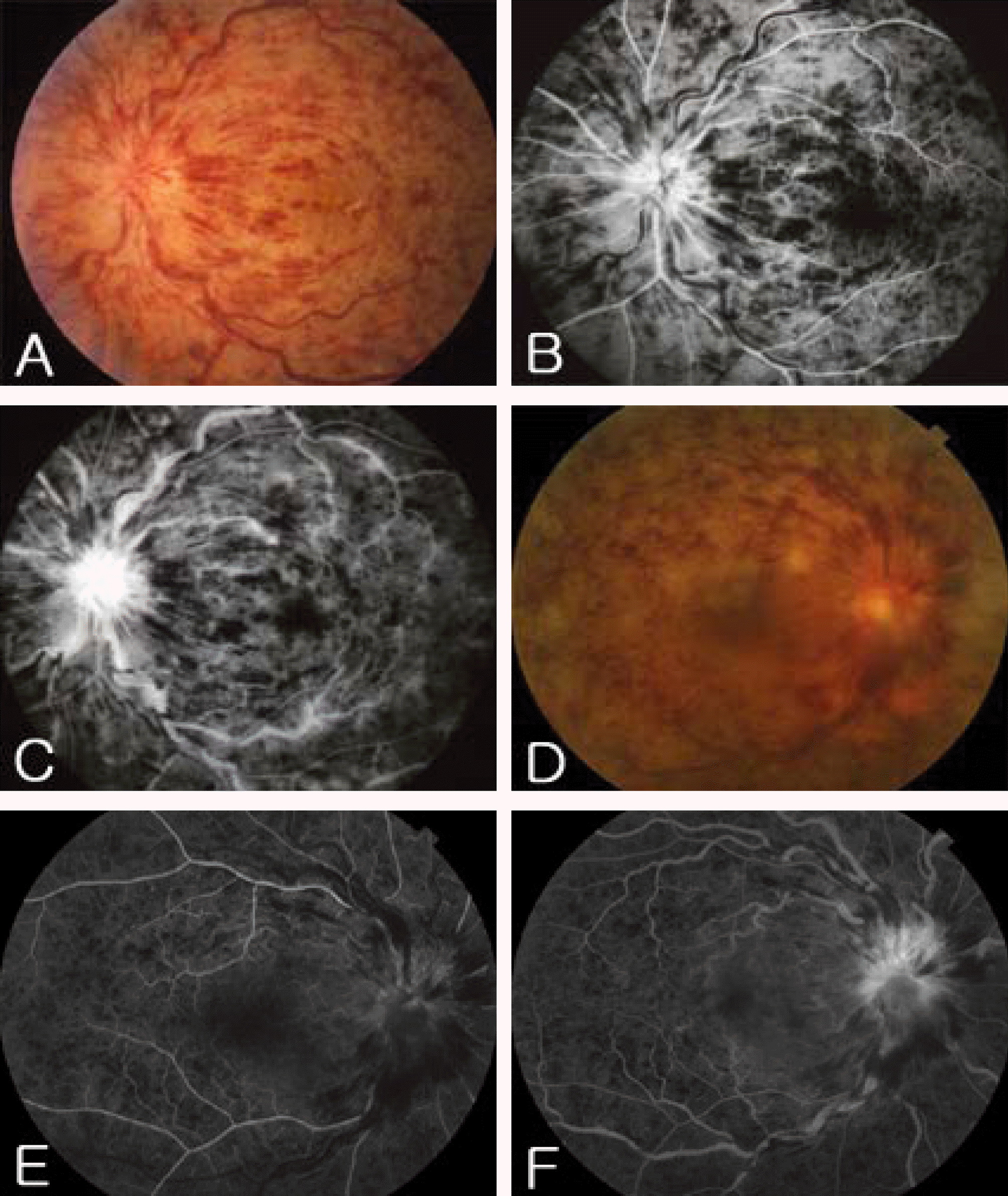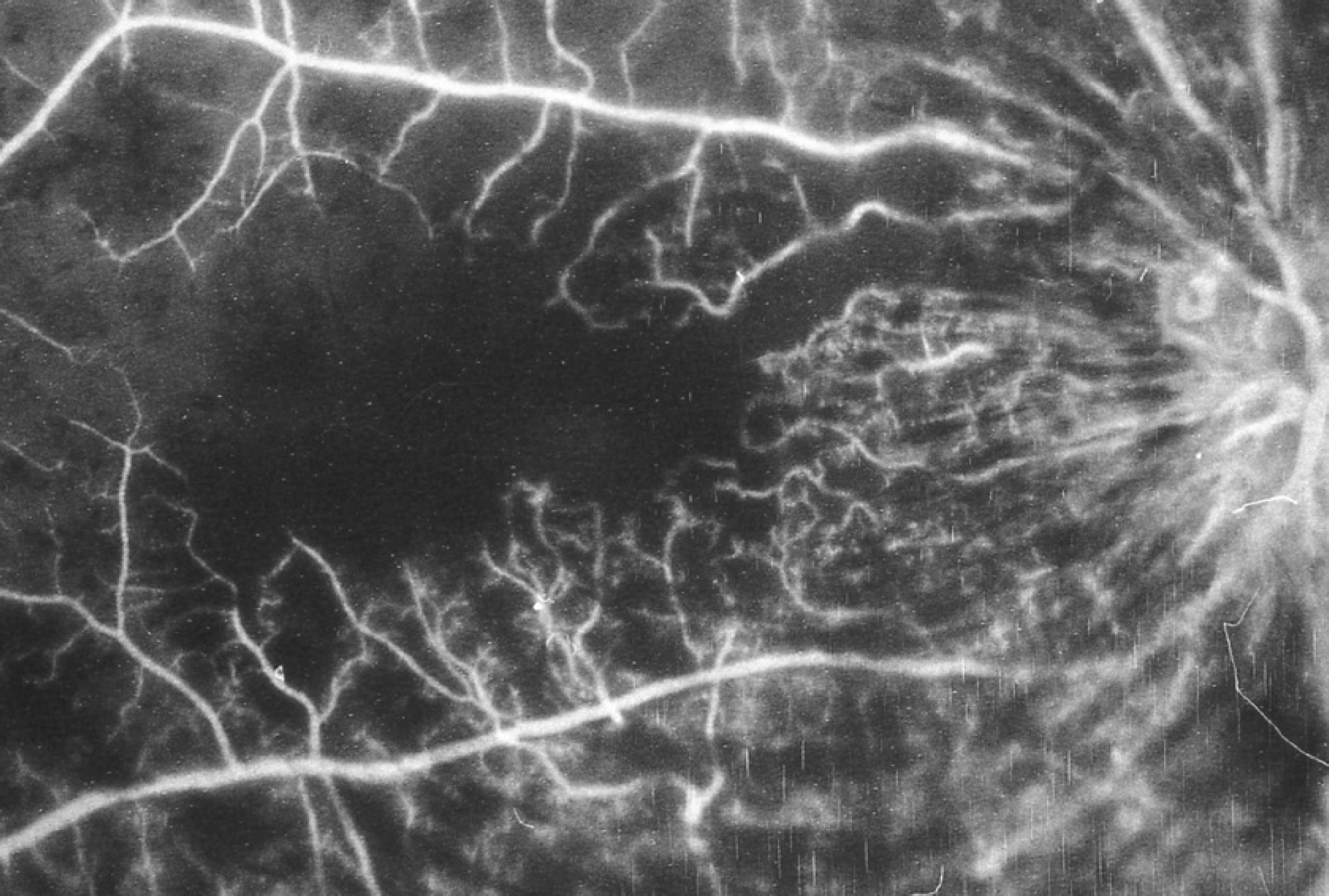Abstract
Purpose
To investigate the characteristics of fluorescein angiograms (FAG) of the optic nerve head and retina according to the presence of optic nerve head swelling (ONHS) in central retinal vein occlusion (CRVO).
Methods
The records of 69 eyes were reviewed, confirmed with the diagnosis of CRVO, and compared for several features according to the presence of ONHS. The best-corrected visual acuities and intraocular pressures were recorded and patterns of retinal hemorrhage were described. The presence of fluorescein filling defects of the optic disc, time till fluorescein started to fill at the optic disc, arteriovenous transit time, and nonperfused areas were assessed using FAG.
Results
Forty-one patients without ONHS (group 1) and 28 patients with ONHS (group 2) were included. The mean ages for groups 1 and 2 were 61.4 and 56.9 years, respectively, and there was no significant difference the mean ages between the groups. The fluorescein filling defect of the optic disc was seen more often in group 1 (n=13) than in group 2 (n=2). Marginal irregularity of the foveal avascular zone due to perifoveal capillary drop out was seen significantly more often in group 1 (n=12) than in group 2 (n=2).
Conclusions
Fluorescein filling defects of the optic disc and perifoveal capillary drop out were more frequently seen in CRVO patients without ONHS. However, longitudinal studies are needed to confirm the prognostic value of ONHS and the correlation of filling defects with progressive optic neuropathy in CRVO.
Go to : 
References
1. Hart CD, Sanders MD, Miller SJ. Benign retinal vasculitis. Clinical and fluorescein angiographic study. Br J Ophthalmol. 1971; 55:721–33.

2. Hayreh SS, Klugman MR, Beri M, et al. Differentiation of ischemic from non-ischemic central retinal vein occlusion during the early acute phase. Graefes Arch Clin Exp Ophthalmol. 1990; 228:201–17.

3. Beaumont PE, Kang HK. Pattern of vascular nonperfusion in retinal venous occlusions occurring within the optic nerve with and without optic nerve head swelling. Arch Ophthalmol. 2000; 118:1357–63.

4. Hvarfner C, Larsson J. Is optic nerve head swelling of prognostic value in central retinal vein occlusion? Graefes Arch Clin Exp Ophthalmol. 2003; 241:463–7.

6. Walters RF, Spalton DJ. Central retinal vein occlusion in people aged 40 years or less: a review of 17 patients. Br J Ophthalmol. 1990; 74:30–5.

8. The Central Vein Occlusion Study Group. Natural history and clinical management of central retinal vein occlusion. Arch Ophthalmol. 1997; 115:486–91.
9. Wirtschafter JD. Optic nerve axons and acquired alterations in the appearance of the optic disc. Trans Am Ophthalmol Soc. 1983; 81:1034–91.
10. Ernest JT. Autoregulation of optic-disk oxygen tension. Invest Ophthalmol. 1974; 13:101–6.
12. Hayreh SS, van Heuven WA, Hayreh MS. Experimental retinal vascular occlusion, I. Pathogenesis of central retinal vein occlusion. Arch Ophthalmol. 1978; 96:311–23.
13. Fujino T, Curtin VT, Norton EW. Experimental central retinal vein occlusion. A comparison of intraocular and extraocular occlusion. Arch Ophthalmol. 1969; 81:395–406.
15. Talusan ED, Schwartz B. Specificity of fluorescein angiographic defects of the optic disc in glaucoma. Arch Ophthalmol. 1977; 95:2166–75.

16. Spaeth GL. Fluorescein angiography: its contributions towards understanding the mechanisms of visual loss in glaucoma. Trans Am Ophthalmol Soc. 1975; 73:491–553.
17. Schwartz B, Rieser JC, Fishbein SL. Fluorescein angiographic defects of the optic disc in glaucoma. Arch Ophthalmol. 1977; 95:1961–74.

18. Arnold AC. Fluorescein angiographic characteristics of the optic disc in ischemic and glaucomatous optic neuropathy. Curr Opin Ophthalmol. 1995; 6:30–5.

19. Hayreh SS. Progress in the understanding of the vascular etiology of glaucoma. Curr Opin Ophthalmol. 1994; 5:26–35.

20. Plange N, Remky A, Arend O. Colour Doppler imaging and fluorescein filling defects of the optic disc in normal tension glaucoma. Br J Ophthalmol. 2003; 87:731–6.

21. Hayreh SS. The blood supply of the optic nerve head and the evaluation of it-myth and reality. Prog Retin Eye Res. 2001; 20:563–93.
Go to : 
 | Figure 1.(A, D) Fundus photographs of central retinal vein occlusion without optic nerve head swelling. (B, C) Fluorescein angiograms show intact fluorescein filling of the optic disc. (E, F) Fluoresecin angiograms show persistent hypofluorescent area of the optic disc due to fluorescein filling defect. |
 | Figure 2.(A, D) Fundus photographs of central retinal vein occlusion with optic nerve head swelling. (B, C) Fluorescein angiograms show intact fluorescein filling of the optic disc. (E, F) Fluorescein angiograms show persistent hypofluorescent area of the optic disc due to fluorescein filling defect. |




 PDF
PDF ePub
ePub Citation
Citation Print
Print



 XML Download
XML Download